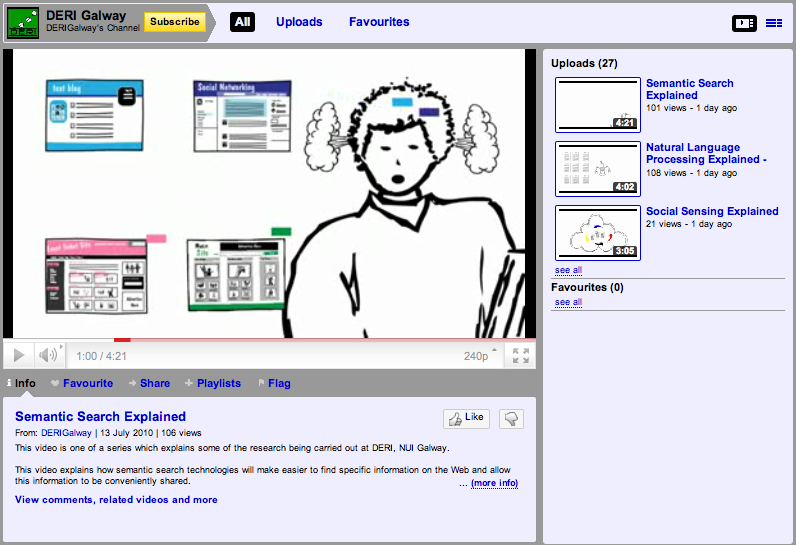I’m working on online argumentation: Making it easier to have discussions, get to consensus, and understand disagreements across websites.
Here are the 3 key questions and the most closely related work that I’ve identified in the first 9 months of my Ph.D.
Read on, if you want to know more. Then let me know what you think! Suggestions will be especially helpful since I’m writing my first year Ph.D. report, which will set the direction for my second year at DERI.
Enabling a Social Semantic Web for Argumentation
Argumentative discussions occur informally throughout the Web, however there is currently no way of bringing together all of the discussions on a given topic along with an indication of who is agreeing and who is disagreeing. Thus substantial human analysis is required to integrate opinions and expertise to, for instance, determine the best policies and procedures to mitigate global warming, or the recommended treatment for a given disease. New techniques for gathering and organising the Social Web using ontologies such as FOAF and SIOC show promise for creating a Social Semantic Web for argumentation.
I am currently investigating three main research questions to establish the Social Semantic Web for argumentation:
- How can we best define argumentation for the Social Semantic Web, to isolate the essential problems? We wish to enable reasoning with inconsistent knowledge, to integrate disparate knowledge, and identify consensus and disputes. Similar questions and techniques come up in related but distinct areas, such as sentiment analysis, dialogue mapping, dispute resolution, question-answering and e-government participation.
- What sort of modular framework for argumentation can support distributed, emergent argumentation — a World Wide Argumentation Web? Some Web 2.0 tools, such as Debatepedia, LivingVote, and Debategraph, provide integrated environments for explicit argumentation. But our goal is for individuals to be able to use their own preferred tools — in a social environment — while understanding what else is being discussed.
- How can we manage the tension between informality and ease of expression on the one hand and formal semantics and retrievability/reusability on the other hand? Minimal integration of informal arguments requires two pieces of information: a statement of the issue or proposition, and an indication of polarity (agreement or disagreement). How can we gather this information without adding cognitive overhead for users?
Related Work
Ennals et al. ask: ‘What is disputed on the Web? (Ennals 2010b). They use annotation and NLP techniques to develop a prototype system for highlighting disputed claims in Web documents (Ennals 2010a). Cabanac et al. find that two algorithms for identifying the level of controversy about an issue were up to 84% accurate (compared to human perception), on a corpus of 13 arguments. These are useful prototypes of what could be done; Ennals prototype is indeed a Web-scale system, but disputed claims are not arguments.
Rahwan et al. (2007) present a pilot Semantic Web-based system, ArgDF, in which users can create arguments, and query to find networks of arguments. ArgDF is backed with the AIF-RDF ontology, and uses Semantic Web standards. Rahwan (2008) surveys current Web2.0 tools, pointing out that integration between these tools is lacking, and that only very shallow argument structures are supported; ArgDF and AIF-RDF are explained as an improvement. What is lacking is uptake in end-user orientated (e.g. Web 2.0) tools.
The Web2.0 aspect of the problem is explored in several papers, including Buckingham Shum (2008), which presents Cohere, a Web2.0-style argumentation system supporting existing (non-Semantic Web) argumentation standards, and Groza et al. (2009) which proposes a abstract framework for modeling argumentation. These are either minimally implemented frameworks or stand-alone systems which do not yet support the distributed, emergent argumentation envisioned, as further elucidated by Buckingham Shum (2010).
References with links to preprints
- S. Buckingham Shum, “Cohere: Towards Web 2.0 Argumentation,” Computational Models of Argument – Proceedings of COMMA 2008, IOS Press, 2008.
- S. Buckingham Shum, AIF Use Case: Iraq Debate, Glenshee, Scotland, UK: 2010. http://projects.kmi.open.ac.uk/hyperdiscourse/docs/AIF-UseCase-v2.pdf
- G. Cabanac, M. Chevalier, C. Chrisment, and C. Julien, “Social validation of collective annotations: Definition and experiment,” Journal of the American Society for Information Science and Technology, vol. 61, 2010, pp. 271-287.
- R. Ennals, B. Trushkowsky, and J.M. Agosta, “Highlighting Disputed Claims on the Web,” WICOW 2010, Raleigh, North Carolina: 2010.
- R. Ennals, D. Byler, J.M. Agosta, and Barboara Rosario, “What is Disputed on the Web?,” WWW 2010, Raleigh, North Carolina: 2010.
- T. Groza, S. Handschuh, J.G. Breslin, and S. Decker, “An Abstract Framework for Modeling Argumentation in Virtual Communities,” International Journal of Virtual Communities and Social Networking, vol. 1, Sep. 2009, pp. 35-47.
- I. Rahwan, “Mass argumentation and the semantic web,” Web Semantics: Science, Services and Agents on the World Wide Web, vol. 6, Feb. 2008, pp. 29-37.
- I. Rahwan, F. Zablith, and C. Reed, “Laying the foundations for a World Wide Argument Web,” Artificial Intelligence, vol. 171, Jul. 2007, pp. 897-921.
